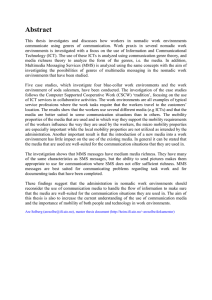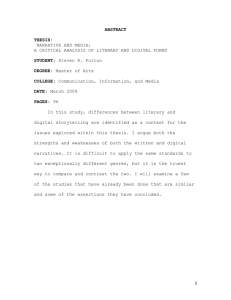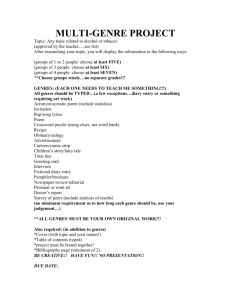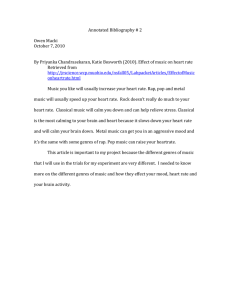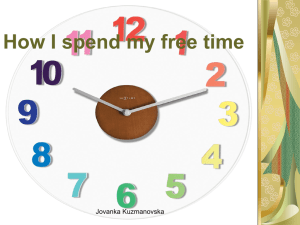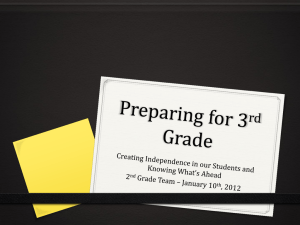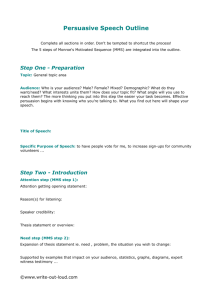Genres of Communication in Nomadic Work Environments: Cand. Scient Thesis
advertisement
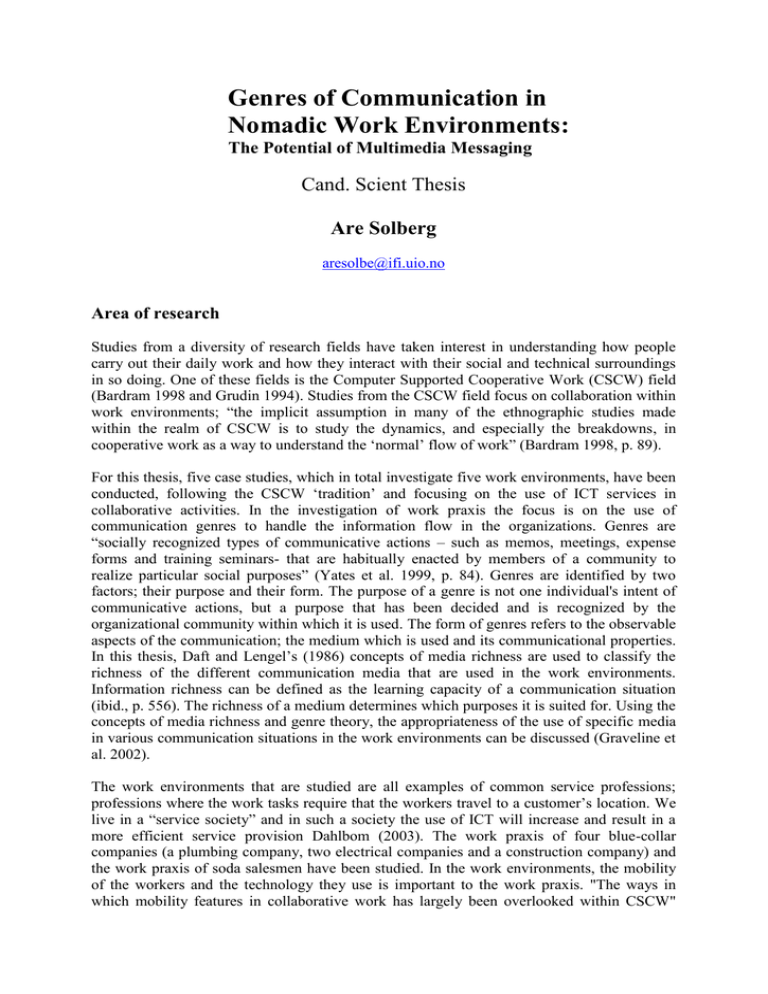
Genres of Communication in Nomadic Work Environments: The Potential of Multimedia Messaging Cand. Scient Thesis Are Solberg aresolbe@ifi.uio.no Area of research Studies from a diversity of research fields have taken interest in understanding how people carry out their daily work and how they interact with their social and technical surroundings in so doing. One of these fields is the Computer Supported Cooperative Work (CSCW) field (Bardram 1998 and Grudin 1994). Studies from the CSCW field focus on collaboration within work environments; “the implicit assumption in many of the ethnographic studies made within the realm of CSCW is to study the dynamics, and especially the breakdowns, in cooperative work as a way to understand the ‘normal’ flow of work” (Bardram 1998, p. 89). For this thesis, five case studies, which in total investigate five work environments, have been conducted, following the CSCW ‘tradition’ and focusing on the use of ICT services in collaborative activities. In the investigation of work praxis the focus is on the use of communication genres to handle the information flow in the organizations. Genres are “socially recognized types of communicative actions – such as memos, meetings, expense forms and training seminars- that are habitually enacted by members of a community to realize particular social purposes” (Yates et al. 1999, p. 84). Genres are identified by two factors; their purpose and their form. The purpose of a genre is not one individual's intent of communicative actions, but a purpose that has been decided and is recognized by the organizational community within which it is used. The form of genres refers to the observable aspects of the communication; the medium which is used and its communicational properties. In this thesis, Daft and Lengel’s (1986) concepts of media richness are used to classify the richness of the different communication media that are used in the work environments. Information richness can be defined as the learning capacity of a communication situation (ibid., p. 556). The richness of a medium determines which purposes it is suited for. Using the concepts of media richness and genre theory, the appropriateness of the use of specific media in various communication situations in the work environments can be discussed (Graveline et al. 2002). The work environments that are studied are all examples of common service professions; professions where the work tasks require that the workers travel to a customer’s location. We live in a “service society” and in such a society the use of ICT will increase and result in a more efficient service provision Dahlbom (2003). The work praxis of four blue-collar companies (a plumbing company, two electrical companies and a construction company) and the work praxis of soda salesmen have been studied. In the work environments, the mobility of the workers and the technology they use is important to the work praxis. "The ways in which mobility features in collaborative work has largely been overlooked within CSCW" (Luff and Heath 1998, p. 305). Some researchers, however, like Luff and Heath have done extensive research focusing on the mobility of both technology and workers. Their results show that it is important to carefully consider mobility of both people and technology when studying work praxis in order to better understand them. Luff and Heath’s concepts of different types of physical mobility are used in combination with Kristoffersen and Ljungberg’s (2000) concept of mobile work to discuss the movement of people and the mobility properties of the communication media that are used in the work environments. The way in which the mobility properties influence the appropriateness of the use of specific media for the communicational purposes they are used for is also discussed. In Norway, a project led by Telenor Research and Development called NOMADE 2007 (Julsrud et al. 2002) has studied the nature of nomadic work environments and the use of and need for ICTs in these environments. Their results show an extensive use of mobile technology like mobile phones. The work environments investigated in this thesis fit the description nomadic work environments, since the workers’ work praxis requires that they travel between locations. This thesis is meant to continue the research initiated by the NOMADE 2007 project. This thesis investigates some of the same issues; however, the aim is to produce a more detailed description of the use of ICT (i.e. media) in nomadic work environments than what was presented by the NOMADE 2007 project. The research problem The blue-collars' and the soda salesmen’s work environments are nomadic work environments where the workers need access to various ICT services while they are on the move. The results found by the NOMADE 2007 project (ibid., p. 54) indicate that multimedia messages (MMS), and especially the possibility to send pictures between mobile phones and between mobile phones and PCs, might be useful for communication among blue-collars. MMS is a relatively new service which expands the functionality of SMS. As with SMS, textual messages can be sent between a sender and a recipient. MMS, however, makes it possible to send much longer messages. In addition pictures, video-clips, animation and sound-clips can be included in MMS-messages. Since MMS is a relatively new service, the amount of research regarding the use of MMS is very limited. Koskinen et al. (2002) have studied the use of what they call “mobile visual messages” which similarly to MMS involves pictures being sent between mobile phones. They say that “[m]uch like the transition from radio to TV, the evolution from text messaging to multi-media messaging marks a whole new era of mobile communications, combining images with sound and text” (ibid., p. 105). Ling et al. and Julsrud et al. (2004) have investigated the use of genres of SMS and MMS communication in the work environments of blue-collars and salesmen in the MEMO (acronym for messaging services in mobile environments, translated from Norwegian) project which follows the work begun in the NOMADE 2007 project. Their findings indicate that MMS offers functionality which might be a fruitful addition to the communication media which are currently used. This thesis has two main focuses; to investigate how communication media are used to in nomadic work environments and to investigate how multimedia messaging can be used to communicate in these work environments. Thus, two main problem statements form the basis of this thesis: 1 2 How are communication genres used to handle the flow of information in nomadic work environments? How can genres of multimedia messaging be used to handle the flow of information in nomadic work environments? To investigate the first research problem the work praxis of service workers, blue-collars and salesmen, working in several nomadic work environments is investigated in detail through five case studies. The investigation focuses on how service workers use communication genres in their work praxis. The context which the workers work in, i.e. the work environment which consists of the organization and its administration, the customers etc., is investigated and discussed in order to better understand how the workers use communication genres and why they use them the way they do. Since mobility of the workers and the technology they use is an important part of these environments, these aspects are discussed in detail and related to the use of communication genres. The second research problem requires that the properties of MMS as a communication medium are investigated. Concepts from media richness theory (Daft and Lengel 1986) and communication genres theory (Graveline et al. 2000, Yates et a. 1999 and Ling et al.) are used to discuss which communication situations multimedia messaging is suited for. In addition, workers in nomadic work environments have been interviewed regarding the possible introduction of MMS communication in their work praxis. Based on the discussion of these two problem statements, the aim of this thesis is to uncover the potential of genres of multimedia messaging in the work environments that have been studied.
